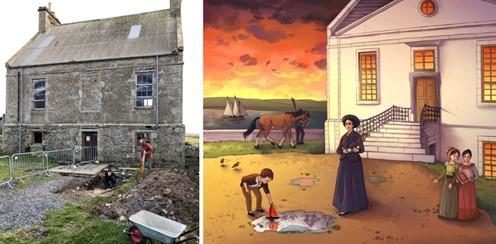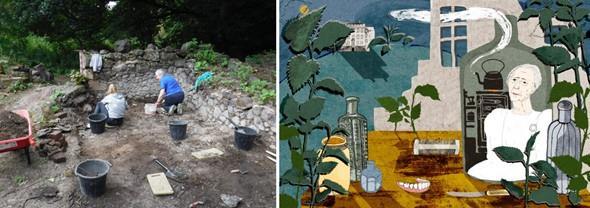Archaeological discoveries made across Scotland during the coronavirus lockdown have been brought to life by three digital artists.
Many community-led archaeological activities have been called off during the pandemic but several groups nonetheless managed to resume their work after restrictions eased.
And they have made a series of fascinating finds, including uncovering a medieval gravestone, servants’ accommodation and a magnificent moat.
Those discoveries have been digitally recreated by Scottish artists, designers and illustrators as part of a campaign by the country’s archaeology hub, Dig It!
Jeff Sanders, project manager at the Society of Antiquaries of Scotland project, said: “Scottish archaeology is all about discovering the nation’s stories.
“These are the chapters of people’s lives that we sometimes forget about, but that archaeology is uniquely placed to write.
“Scotland’s archaeology strategy emphasises that remains, such as the ones uncovered this year, connect us to the people in the past and we believe that the work of these groups and digital artists have helped to strengthen that connection this summer.”
The first of the ‘Scotland Digs Digital’ campaign’s discoveries was made by the Kirkmichael Trust in the Highlands in July.
Volunteers there uncovered a 450-year-old gravestone – possibly the oldest dated gravestone ever recorded in the Black Isle.
Using a surveying technique called photogrammetry, they confirmed the weather-worn inscription on the slab reads “5th of February 1577” and it commemorates “Ihon Makoillich” – or John MacCulloch.
That find has been reimagined by Stirling based artist Li Caswell-Sou in a comic showing the stone carver at work in 1577 and a blind child learning through the tactile nature of the carved stone.
The scene mirrors the trust’s own encouragement of visually impaired people in the local community to experience their newly carved medieval stones by touch.
The second notable find was made by the Edinburgh Archaeological Field Society at its excavation of the servants’ accommodation at Cammo Estate, which was once home to one of Edinburgh’s grandest mansions.
Volunteers uncovered items including tonic and perfume bottles, false teeth and cooking equipment which may have belonged to the 70-year-old housekeeper and cook, Margaret Wright, who was left behind when the family from the mansion went off on a world tour in about 1911.
That departure scene has been reimagined by Glasgow-based illustrator and designer Miranda Stuart and the society will welcome visitors to tour the site once it is safe to do so.
In Orkney, volunteers made the third find to be reimagined as part of the project.
They uncovered new details about the birthplace and family home of John Rae, a 19th-century surgeon who helped map the Arctic coast, while excavating the Hall of Clestrain.
President of the John Rae Society, Andrew Appleby, said they discovered “the moat that went around the hall was a far greater feature than was ever imagined” and that it contained bird bones, which hint at John’s wild diet, and sherds of rare spongeware pottery that he may have used.
In the reimagined scene by Sara Julia Campbell, an Edinburgh-based illustrator, John’s future is reflected in a puddle while playing in the courtyard with sisters Janet Love and Marion Sibbald, and mother Margaret Glen.
The illustration also shows the recently discovered moat, a large horseshoe and the birds that John may have hunted.
While visits to each of these sites are still off-limits, this new digital campaign by Dig It! hopes to bring the finds to life in the meantime.
Amy Eastwood, head of grants at Historic Environment Scotland, added: “The Scotland Digs Digital campaign was a fantastic way to engage people with Scotland’s heritage while sharing stories and updates from the archaeology community during a time when a lot of archaeological work throughout the country was put on hold.”


